This new exhibit shows how Latino and African-American solidarity built a better Austin
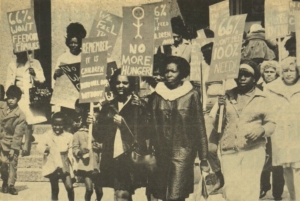
Members of the Austin Welfare Rights Organization (AWRO) led protests at the Texas State Capitol against proposed cuts to welfare checks. (Published in The Rag Vol. 4 No. 17, March 3, 1970).
(Remezcla) Long before East Austin became synonymous with condominiums and trendy bars, it was home to Black and brown communities who were the foundation of the city. Before gentrification forced them out due to higher property taxes and a changing environment, nearly every corner east of Interstate 35 was beaming with Tejano cantinas and restaurants, and the the neighborhood’s nightclubs and shops catered to African Americans. Back then, East Austin offered an intimate community where neighbors worked together and went to school together.
Today, Joe’s Bakery & Coffee Shop is one of the few establishments left from this bygone era, but a new exhibit hopes to bring the past into focus in a fresh way, focusing on how the collaborations between Latinos and African Americans changed Austin.
From January 9 to April 6, the Juntos/Together: Black and Brown Activism in Austin, Texas From 1970-1983 exhibit will give us an in-depth look at this alliance. Juntos/Together – curated by anthropologists Alan Garcia and Rachel E. Winston – will be on view at the George Washington Carver Museum, Cultural and Genealogy Center in Austin. (more)
Tracing Your Roots: How Did My Ancestors Come to Texas?
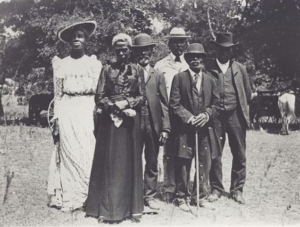
Celebrants at a Juneteenth Emancipation Day observation June 19, 1900, in Texas (Wikimedia Commons)
(The Root) On the trail of a great-great-grandfather from Louisiana who farmed in Texas at the height of Jim Crow.
Dear Professor Gates:
I have been working on my family history for several years; now I have hit a brick wall with my great-great-grandfather John H. McCants. I have only been able to locate him in the 1910 census in Angelina County, Texas. In this census, he is living with my great-great-grandmother Azalea/Azilee; their their daughters, Izora, Mattie, Verona; and Azalea’s father, Matthew “Mat” Hackney.
My great-uncle told me that John was a very light-skinned man and a reverend. Azalea died shortly after her last child, my great-grandmother Sammie Cleo McCants, [who] was born in 1918. Everyone seems to disappear from the census records until 1930, where you find the oldest girls married and the younger children living with either their siblings or with future in-laws. John is nowhere to be found.
I have tried searching Texas and Louisiana and have found a few people with the same last name, but I can’t seem to tie anything together. How else do I go about solving this mystery? – Quinette (more)
TCU aims to draw students of color, change campus culture in new program
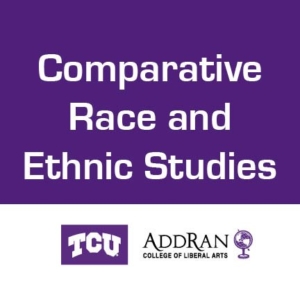 There’s a new major at Texas Christian University in Fort Worth dedicated to shining a light on issues around race. It’s part of broader efforts at the university, where students of color have raised concerns about the campus climate.
There’s a new major at Texas Christian University in Fort Worth dedicated to shining a light on issues around race. It’s part of broader efforts at the university, where students of color have raised concerns about the campus climate.
(The Texas Tribune) There’s a new major at Texas Christian University in Fort Worth dedicated to shining a light on issues around race and ethnicity. It’s part of broader efforts at the university to attract and retain more students of color and improve the campus culture.
TCU launched the new Comparative Race and Ethnic Studies program this past fall with two introductory classes aimed at equipping students with tools to analyze how race and ethnicity play out in politics, culture, and society – and giving them a grounding in literature from and about marginalized communities.
On the last week of class of the fall semester, students in one of the intro classes gave group presentations on African-American college athletes, the experiences of students of color at TCU and on racial health disparities.
There’s another goal to this class and the new program in general: to help students build cultural competence, said Lynn Hampton, a sociologist in the honors college who teaches the intro course.
“A lot of them are coming from high schools that are homogenous – racially, economically, culturally, religiously – and so their prior exposure to engaging in conversations with diversity-related issues is limited,” Hampton said. (more)
Audio: TCU aims to draw students of color, change campus culture in new program.
Literary review, “Goddess of Anarchy”: Latina heroine or black radical? The complicated story of Lucy Parsons
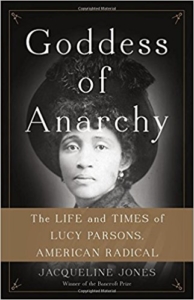 (The Washington Post) Lucy Parsons occupies an unusual position in American history: a prominent woman noted as much for her acts of brilliance and bravery as for her evasiveness and contradictions.
(The Washington Post) Lucy Parsons occupies an unusual position in American history: a prominent woman noted as much for her acts of brilliance and bravery as for her evasiveness and contradictions.
Parsons spent most of her life in Chicago, where a park named in her honor calls her the first “Chicana socialist labor organizer.” Born circa 1853, Parsons said she was of Mexican and Indian descent and from Texas – an Aztec genealogy dating before Columbus. Elsewhere she’s been recognized as “the first Black woman to play a prominent role in the American Left.”
These differing narratives are indicative of a life that defies easy categorization and has challenged assessments of Parsons’s legacy.
Parsons was an anarchist, socialist, journalist and labor organizer who commanded audiences by the thousands. Beginning in the late 1880s, she scathingly criticized the American political economy and the titans of industry for exploiting working people. She was one of the most outspoken defenders of free speech and free assembly who was relentlessly persecuted by state agents opposed to her militancy.
With “Goddess of Anarchy,” prize-winning historian Jacqueline Jones has written the first critical, comprehensive biography of Parsons that seeks to peel back the layers of her complex life. (more)
TIPHC Bookshelf
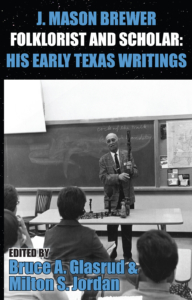 Published scholarship on black history in Texas is growing and we’d like to share with you some suggested readings, both current and past, from some of the preeminent history scholars in Texas and beyond. We invite you to take a look at our bookshelf page – including a featured selection – and check back as the list grows. A different selection will be featured each week. We welcome suggestions and reviews. This week, we offer, “J. Mason Brewer, Folklorist and Scholar: His Early Texas Writings,” edited by Bruce A. Glasrud and Milton S. Jordan.
Published scholarship on black history in Texas is growing and we’d like to share with you some suggested readings, both current and past, from some of the preeminent history scholars in Texas and beyond. We invite you to take a look at our bookshelf page – including a featured selection – and check back as the list grows. A different selection will be featured each week. We welcome suggestions and reviews. This week, we offer, “J. Mason Brewer, Folklorist and Scholar: His Early Texas Writings,” edited by Bruce A. Glasrud and Milton S. Jordan.
The editors present a collection of the writings of famed African American teacher and scholar, John Mason Brewer. In this collection, Glasrud and Jordan pulled together a wide range of Brewer’s publications that were written in and about Texas. These works were published over a lengthy period of time, beginning in the early 1920s and continuing to mid-century.
This Week in Texas Black History, Jan. 21-27
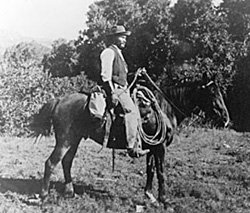
George McJunkin
Jan21
On this day in 1922, George McJunkin died in Folsom, New Mexico. Born a slave in Midway, Texas, McJunkin is credited with one of the most significant finds in archeological history, “Folsom Man.” A cowboy and amateur archeologist, McJunkin was inspecting damage on the Crowfoot Ranch, where he was foreman, after a 1908 flood when he discovered bison bones. He realized the find was significant but no experts would look at his discovery until after his death in 1922. The remains were part of a Paleo-Indian site dating back as far as 9000 BCE, where ancient bison had been killed by early Indians using special tools, now referred to as Folsom points. With this find, scientists were able to establish a human presence in North America about 7,000 years earlier than had previously been thought. The site eventually yielded human remains that became known as “Folsom Man.”

Lovie Smith
Jan21
On this date in 2007, Lovie Smith of Big Sandy, Texas became the first African-American professional head football coach to qualify a team for the NFL’s Super Bowl. Smith’s Chicago Bears beat the New Orleans Saints, 39-14, in the NFC championship game. Smith led the Big Sandy Wildcats to three consecutive state championships in high school and was all-state three times as an end and linebacker.
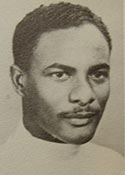
Dr. Herman A. Barnett, III
Jan22
On this day in 1926, Dr. Herman A. Barnett, III was born in Austin. In 1950, he became the first black student at the University of Texas Medical Branch in Galveston. In the previous year, Barnett had been accepted to the school but as a student in Houston at Texas State University for Negroes (Texas Southern University) attending UTMB under a contract program between the schools. The program was stopped after the Veterans Administration(Barnett’s tuition was covered by the GI Bill) refused to recognize the contract system and Barnett’s attorney threatened legal action. Barnett became a prominent surgeon and anesthesiologist and was a graduate of Huston College in Austin. During WWII, he was a Tuskegee Airman (332nd Fighter Group) and in 1968 became the first African-American to serve on the Texas State Board of Medical Examiners. In 1973, Barnett was the first black elected president of the Board of Trustees of the Houston Independent School District.
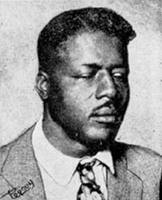
Blind Willie Johnson
Jan22
Blues and gospel singer Blind Willie Johnson was born on this day in 1897 in Independence, Texas. While Jan. 22 is the date noted on his death certificate, other accounts list his birth on December 6, 1902 near Temple, Texas. Johnson recorded 30 songs, including his most popular, “Dark Was the Night – Cold Was the Ground,” a song about the crucifixion of Jesus.
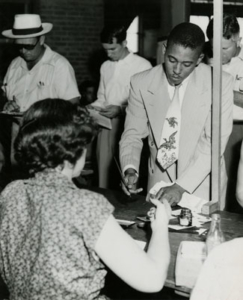
John Saunders Chase, Jr.
Jan23
John Saunders Chase, Jr. was born on this day in 1925 in Annapolis, Md. On June 7, 1950, when Chase enrolled at the University of Texas, the school became the first major university in the South to enroll an African-American. Chase earned a Master of Architecture degree in 1952 and became the first African-American graduate of the university. That same year, Chase became the first licensed African-American architect in Texas and was the only black architect licensed in the state for almost a decade.
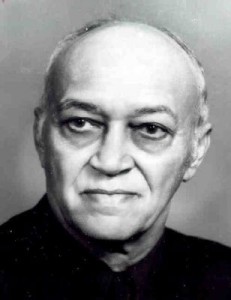
J. Mason Brewer
Jan24
On this date in 1975, J. Mason Brewer died. Brewer, considered the premier African-American folklorist of the twentieth century, was born in Goliad in 1896 and became the first author and speaker to use black American dialect extensively in front of and to all audiences, particularly when dealing with folklore. He was the first black member of both the Texas Folklore Society and the Texas Institute of Letters. His most noted works include “Aunt Dicy Tales,” and an anthology, “American Negro Folklore,” for which he won the Chicago Book Fair Award in 1968.
Jan25
On this day in 1915, Independence Heights became the first incorporated black city in Texas. Located northeast of Houston, it had a population of 600 and G.O. Burgess was its mayor. The area was annexed to Houston on December 26, 1929.
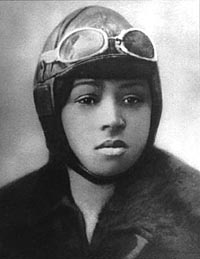
Bessie Coleman
Jan26
Bessie Coleman was born on this date in 1892 in Atlanta, Texas. Thwarted by racism in her quest to become a pilot, Coleman eventually went to France to train and in 1921 became the first licensed black pilot in the world. As a stunt pilot, she became known as “Queen Bess” and “Brave Bessie” in 1995 the U.S. Postal Service issued a stamp in Bessie’s honor and in 2000 was inducted into the Texas Aviation Hall of Fame. The main road to Atlanta’s airport is named Bessie Coleman Drive.
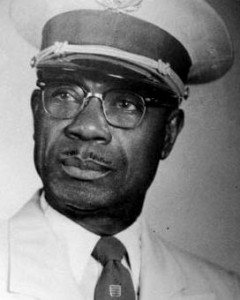
B.L. Joyce
Jan26
On this date in 1980, former L.C. Anderson High School band leader B.L. Joyce died in San Jose, California. Joyce was born in the late 1800s in Plaquemine, La. He attended Samuel Huston College in Austin before becoming band director at Anderson High School, from 1934 to 1955. Under his leadership, the band won the state championship seven times between 1940 and 1953 at the Prairie View Interscholastic League competitions. Among his many star pupils was noted jazz trumpeter Kenny Dorham.

Kirk Franklin
Jan26
On this date in 1970, contemporary gospel musician and producer Kirk Franklin was born in Fort Worth. A multi – Grammy Award winner, Franklin learned to play piano as an infant and by age 11 was leading the Mt. Rose Baptist Church adult choir in Dallas. His first album, 1993’s “Kirk Franklin & the Family,” spent 100 weeks on the gospel charts (several times as No. 1), crossed over to the R&B charts, and became the first gospel debut album to go platinum.
Blog: Ron Goodwin, Ph.D., author, PVAMU history professor
Ron Goodwin’s bi-weekly blog appears exclusively for TIPHC. Goodwin is a San Antonio native and Air Force veteran. Generally, his column addresses contemporary issues in the black community and how they relate to black history. He and the TIPHC staff welcome your comments.
Latest Entries
A New Hope
Forgive me for borrowing the title of one of the most profitable films in history, “Star Wars: A New Hope.” I’ve always been enamored by space. I’m a child of the 1960s and I remember playing with my Major Matt Mason action figure (not a doll!) as my family [...]
Tell me the truth
Democracy – a) government by the people, b) a government in which the supreme power is vested in the people and exercised by them, directly or indirectly through a system of representation usually involving periodically held free elections. Merriam-Webster Dictionary There were many things I learned from my father. [...]
Submissions Wanted
Historians, scholars, students, lend us your…writings. Help us produce the most comprehensive documentation ever undertaken for the African American experience in Texas. We encourage you to contribute items about people, places, events, issues, politics/legislation, sports, entertainment, religion, etc., as general entries or essays. Our documentation is wide-ranging and diverse, and you may research and write about the subject of your interest or, to start, please consult our list of suggested biographical entries and see submission guidelines. However, all topics must be approved by TIPHC editors before beginning your research/writing.
We welcome your questions or comments. Please contact Mr. Michael Hurd, Director of TIPHC, at mdhurd@pvamu.edu.
